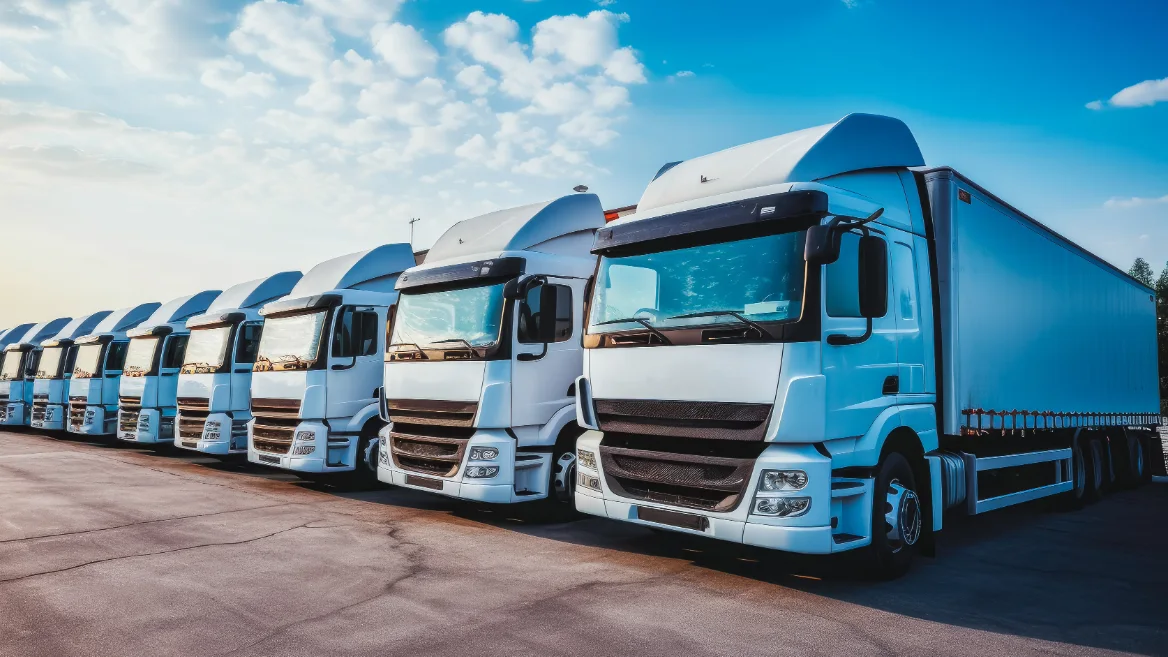Keeping a fleet of HGVs modern and compliant isn’t cheap. Between new emissions standards, fuel costs and maintenance, replacing ageing trucks can drain cash reserves quickly.
That’s why many operators are turning to HGV finance and leasing options to fund replacements more strategically.
In this guide, we’ll explain how HGV and truck financing models work in the UK, what they cost, and what to consider before signing. Whether you run five vehicles or fifty, choosing the right finance structure can help you stay competitive, compliant and cash-flow-positive.
What we’ll cover
Fleets, bookings, subcontractors, compliance & payments.
With HX, you can manage them all in one place.
Why fleet replacement planning matters
Replacing trucks on time isn’t just about avoiding breakdowns. It’s about protecting your bottom line and your reputation.
Older trucks cost more to maintain, burn more fuel and often fall short of new emissions requirements. With HGV road tax and low-emission zones adding pressure, keeping older vehicles can quickly become uneconomical.
A structured replacement plan also helps with driver satisfaction and reliability. Drivers prefer modern vehicles with better comfort, safety and fuel efficiency. For operators, that means fewer missed haulage contracts, less downtime, and smoother operations across your business.
The challenge is finding a way to fund those replacements without tying up large amounts of capital. That’s where HGV finance and lorry leasing come in.
The main types of HGV finance and lorry leasing
There are several ways to fund new trucks depending on whether you want ownership, flexibility or predictable monthly costs. Below are the four most common HGV finance and HGV leasing options, explained in plain terms.
Operating lease or contract hire
An operating lease, sometimes called contract hire, is the most common choice for fleet operators. You pay a fixed monthly amount to use the truck for an agreed term, usually three to seven years. When the contract ends, you return the vehicle.
- The finance company owns the truck and carries the resale risk.
- Maintenance and servicing are often included.
- You don’t need to pay a deposit or worry about depreciation.
- It’s ideal for keeping fleets modern and predictable.
- Be mindful of mileage limits and return conditions, as extra charges may apply.
This form of HGV leasing suits operators who prefer low risk and regular vehicle updates.
Finance lease or lease purchase
A truck lease of this type works slightly differently. You still pay monthly instalments, but you have more flexibility at the end. You can extend the lease, share the resale value, or buy the vehicle outright.
- Ownership can transfer to you once final payments are made.
- You share some of the residual value risk with the finance provider.
- It offers more control than contract hire but higher payments.
- Useful if you plan to keep vehicles longer.
It bridges the gap between leasing and outright ownership, giving flexibility without a large upfront cost.
Hire purchase (HP)
Hire purchase is the simplest form of HGV finance for operators who eventually want full ownership. You pay a deposit, then regular monthly payments until the final instalment transfers ownership to you.
- You own the truck outright at the end of the term.
- The vehicle appears as an asset on your balance sheet.
- You handle maintenance, HGV insurance, and resale value.
- A higher deposit or interest rate may apply compared to leasing.
Hire purchase works well if you want long-term control of your assets rather than regular upgrades.
Sale and leaseback
If you already own vehicles, a sale and leaseback deal can free up working capital. You sell your used HGVs to a finance provider and lease them back or lease new replacements.
- The finance company owns the assets after purchase.
- You continue using the vehicles under a lease agreement.
- This structure improves liquidity while keeping operations running.
- Long-term costs can be higher, so contracts should be reviewed carefully.
For many haulage businesses, this is a quick way to raise funds while keeping your haulage loads moving.

Typical terms, costs and contract structures
Most HGV finance and leasing agreements run between three and seven years. The term length affects your monthly payments and residual value.
Finance providers calculate costs based on:
- The expected resale value of the truck at the end of the term.
- Annual mileage or usage limits.
- Maintenance options (included or excluded).
- Credit rating and deposit.
A shorter term usually means higher payments but newer vehicles more often. Longer terms reduce monthly costs but increase maintenance risk.
Many leasing plans allow for maintenance packages, covering servicing, tyres and inspections. This can simplify budgeting and keep uptime high across haulage and logistics operations.
Another advantage: lease payments are typically treated as operating expenses and may be tax deductible, making HGV finance an attractive option for managing cash flow.
What to consider before signing a finance or leasing deal
Before signing any HGV leasing or finance agreement, it’s worth checking a few details carefully.
- Residual value risk: Confirm who carries the risk if resale prices fall.
- Mileage limits: Check the annual allowance. Going over can lead to penalties.
- Maintenance coverage: Know what’s included and what isn’t.
- Early termination clauses: Look at the cost of returning vehicles early or upgrading mid-term.
- Accounting treatment: Leasing can affect how assets appear on your balance sheet.
- Flexibility: Ask if you can replace or upgrade to electric models mid-contract.
- Credit terms: Smaller firms may need a guarantor or pay higher interest.
Regulations also change quickly. Clean Air Zones, low-emission requirements and initiatives around reducing carbon emissions mean operators need flexible agreements that won’t trap them in diesel-only contracts.
It’s also smart to think about operational details, like yard management and vehicle uptime, to see how new lease terms fit your workflow.
When to replace your HGVs and how to plan it
Knowing when to replace a truck isn’t an exact science, but there are common indicators.
- Repair costs start rising faster than depreciation savings.
- Fuel efficiency drops.
- Vehicle downtime increases.
- Regulatory compliance becomes harder to maintain.
Many operators replace haulage vehicles every five to seven years, depending on mileage. If you cover long distances or run bulk transport operations, replacements might happen sooner.
With leasing or contract hire, you can build these replacement cycles into the contract, creating a predictable schedule that fits your workload. That way, you keep your fleet efficient without surprise costs.
The shift toward greener fleets and alternative finance options
The haulage sector is moving towards cleaner transport. Financing is adapting too.
Providers now offer HGV financing options that support electric, hybrid and biofuel trucks. These agreements can include grants, extended terms or upgrade clauses for low-emission vehicles.
Electric trucks have higher upfront costs, but finance models make them accessible without heavy capital outlay. Some providers also include infrastructure support, such as depot charging finance, which ties into the rise of longer heavier vehicles (LHVs) and zero-emission freight initiatives.
Operators focusing on sustainability should look for finance that allows technology updates, so they can switch to cleaner options without major penalties. Over time, greener fleets help cut costs and support carbon emissions targets.
The benefits of leasing for cash flow and risk management
Leasing gives operators access to new vehicles while keeping finances stable.
- No large upfront investment.
- Predictable monthly costs.
- Less exposure to depreciation and resale risk.
- Easier budgeting for maintenance and replacement cycles.
By spreading payments, you keep cash free for other priorities—like staffing, technology or upgrading your TMS and telematics systems. Leasing also makes it easier to grow your fleet gradually instead of taking on heavy debt.
For many hauliers, this flexibility is the difference between staying reactive and planning ahead confidently.
How to choose the right HGV finance provider
Not all finance providers understand haulage operations. The best ones tailor agreements around real-world usage and compliance requirements.
When comparing offers, look for:
- Experience working with HGV fleets.
- Transparent pricing and no hidden end-of-term fees.
- Maintenance options suited to your operating schedule.
- Advanced driver assistance systems (ADAS) included by default.
- Upgrade or early-return flexibility.
- Responsive customer service and support.
It’s also worth checking if the provider handles multiple vehicle types, from different types of lorries to trailers and even courier van leasing options.
That can make long-term fleet planning easier if your business covers multiple transport categories like cold chain logistics or general haulage.
Summary: Why you should cosnider HGV finance
Modern fleets can’t stand still. HGV financing gives you the flexibility to replace vehicles regularly, control cash flow and plan ahead for cleaner transport.
With the right leasing or hire purchase deal, you can stay compliant, manage costs and upgrade without draining capital.
Replacing trucks strategically isn’t just about cost—it’s about keeping your business reliable, efficient and ready for the next shift in transport technology.
Frequently asked questions
What’s the difference between HGV finance and leasing?
Leasing means you pay to use a truck for a set period, then return it at the end. Finance, such as hire purchase, lets you buy the truck over time and own it when payments finish.
Can I get finance for used HGVs?
Yes. Many finance providers offer used truck finance with flexible terms, though the rates and conditions may differ from new models.
How long are typical HGV leases?
Most truck finance and leasing agreements last between three and seven years, depending on mileage and vehicle type.
Can I lease specialist vehicles like refrigerated trucks?
Yes. Finance and leasing providers offer solutions for specialised vehicles used in cold chain logistics and bulk transport, often with custom maintenance packages.



